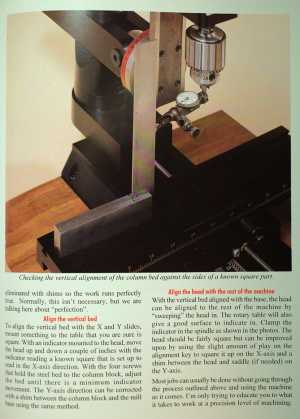- Joined
- Jan 28, 2020
- Messages
- 193
I received a Sherline 5400 this month. I am in the process of checking and and adjusting it. So far, I have checked the flatness of the mill table. I measured 0.0001 inch over 2. 5 inches along the y-axis, and 0.0002 inch over 6 inches along the x-axis. Those values seem good to me. The next step is to align the vertical bed.
Here are the instructions for aligning the vertical bed from Tabletop Machining, by Joe Martin:
"To align the vertical bed with the X and Y slides, mount something to the table that you are sure is square. With an indicator mounted to the head, move the head up and down a couple of inches with the indicator reading a known square that is set up to read in the X-axis direction. With the four screws that hold the steel bed to the column block, adjust the bed until there is a minimum indicator movement. The Y-axis direction can be corrected with a shim between the column block and a mill base using the same method."
A photo of the page for the book is attached. I shows a square on the mill table. It appears to be a machinist square. I don't have "something ... that you are sure is square" -- a reference square. What square and and level of accuracy shall I buy, for this purpose and for general use with the mill?
Karl
Here are the instructions for aligning the vertical bed from Tabletop Machining, by Joe Martin:
"To align the vertical bed with the X and Y slides, mount something to the table that you are sure is square. With an indicator mounted to the head, move the head up and down a couple of inches with the indicator reading a known square that is set up to read in the X-axis direction. With the four screws that hold the steel bed to the column block, adjust the bed until there is a minimum indicator movement. The Y-axis direction can be corrected with a shim between the column block and a mill base using the same method."
A photo of the page for the book is attached. I shows a square on the mill table. It appears to be a machinist square. I don't have "something ... that you are sure is square" -- a reference square. What square and and level of accuracy shall I buy, for this purpose and for general use with the mill?
Karl


